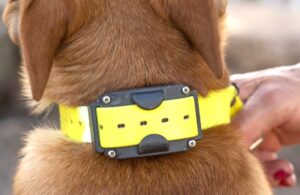Introduction:
In the world of dog training, the term “E-Collar” often surfaces, sparking curiosity and sometimes controversy. E-collars, also known as electronic collars, remote training collars, or shock collars, have become popular tools for training dogs. However, they are also misunderstood. This article aims to provide a comprehensive overview of what is an E-Collar is, how it works, its benefits, potential risks, and how to use it effectively and humanely.
What is an E-Collar?

An E-Collar, short for “electronic collar,” is a device designed to assist in dog training by delivering various forms of stimuli, such as vibration, sound, or a static electric pulse, to the dog. These collars typically come with a remote control that allows the trainer or owner to issue commands from a distance, reinforcing specific behaviors or discouraging undesirable ones.
How Does an E-Collar Work?
An E-Collar operates through a combination of a receiver (attached to the dog’s collar) and a remote control held by the trainer. The receiver is fitted with contact points that rest against the dog’s skin. When a button on the remote is pressed, the collar emits a signal that can be a vibration, sound, or static pulse.
The intensity of the stimulus can usually be adjusted, allowing the trainer to start with the lowest level necessary to get the dog’s attention. The goal is to communicate effectively with the dog, not to punish or cause pain.
Types of E-Collars:
- Vibration Collars: These collars use vibration as a cue. They are often used for deaf dogs or for training purposes where a less intrusive method is preferred.
- Tone Collars: These collars emit a sound, which can be used as a positive reinforcement or to signal a behavior that needs to stop.
- Static Shock Collars: A small electric shock is delivered by these collars. The shock is adjustable and is designed to get the dog’s attention without causing harm when used properly.
- Spray Collars: Instead of a shock or sound, these collars release a spray, typically of citronella, which dogs find unpleasant.
Read More: Waterproof Dog Collars
Benefits of Using an E-Collar:
- Effective for Off-Leash Training: E-collars are particularly useful for training dogs off-leash, providing control even when the dog is at a distance.
- Quick Response: The immediate feedback that an E-Collar provides can help dogs learn faster and more efficiently.
- Versatility: E-collars can be used to correct various behaviors, including excessive barking, jumping, and ignoring commands.
- Customizable: Most E-collars offer different levels of intensity, allowing for a tailored approach that suits the dog’s temperament and training needs.
Why I Train Dogs with E-Collars

Training dogs with e-collars, or electronic collars, is a method that has proven to be highly effective when used responsibly and ethically. Here’s why I choose to incorporate e-collars in my dog training regimen:
1. Precision and Timing
E-collars allow for precise and immediate communication with the dog. Unlike verbal commands or physical cues, which can sometimes be delayed or misunderstood, an e-collar delivers a consistent signal at the exact moment it’s needed. This helps the dog understand exactly what behavior is being corrected or rewarded, leading to faster and more reliable results.
2. Enhanced Off-Leash Control
One of the main advantages of using an e-collar is the ability to train dogs to behave reliably off-leash. Whether it’s a recall command or preventing dangerous behaviors like chasing cars, the e-collar provides an extra layer of security. This is especially beneficial for working dogs, hunting dogs, or pets that enjoy outdoor activities in uncontrolled environments.
3. Improved Communication
E-collars are not just about correction; they are about communication. Modern e-collars have adjustable levels of stimulation, vibration, or sound, allowing the trainer to use the lowest effective setting. This ensures that the communication is clear without causing undue stress or discomfort to the dog. Over time, many dogs respond to the tone or vibration alone, making the need for stimulation minimal.
4. Positive Reinforcement Integration
Contrary to common misconceptions, e-collar training can and should be combined with positive reinforcement. I use treats, praise, and play in conjunction with the e-collar to reinforce desired behaviors. The e-collar simply adds an extra tool to the training toolkit, helping to correct undesirable behavior when necessary.
5. Safety and Well-Being
Safety is a top priority in any training method. E-collars, when used correctly, can prevent dangerous situations, such as a dog running into traffic or getting lost. The ability to control a dog from a distance adds peace of mind, knowing that they will respond to commands even in high-distraction environments.
6. Ethical and Humane Training
The key to humane e-collar training lies in education and responsible use. I ensure that the e-collar is introduced gradually, paired with positive experiences, and used at the lowest effective setting. My goal is not to punish but to guide and communicate effectively with the dog. When used properly, e-collars are a safe and humane tool that enhances the bond between the dog and trainer.
Read More: Mini Educator E-Collar
Potential Risks and Controversies
Despite their benefits, E-Collars have sparked debate among dog trainers and animal welfare organizations. Concerns often revolve around the potential for misuse, which can lead to fear, anxiety, or aggression in dogs. If used improperly, the static pulse can be too intense, causing physical discomfort or emotional distress.
It’s crucial to understand that an E-Collar should not be used as a punishment tool but rather as a way to communicate with your dog. Positive reinforcement and a well-thought-out training plan are key to using an E-Collar humanely and effectively.
How to Use an E-Collar Responsibly?
- Start with Positive Reinforcement: Before introducing an E-Collar, ensure your dog understands basic commands through positive reinforcement. The E-Collar should complement these methods, not replace them.
- Use the Lowest Effective Setting: Always start with the lowest intensity setting and increase only if necessary. The goal is to get the dog’s attention, not to cause discomfort.
- Pair with Commands: Use the E-Collar in conjunction with verbal commands or hand signals. Over time, your dog will learn to respond to the commands without needing the collar.
- Short Training Sessions: Keep sessions brief and positive. Prolonged use can cause unnecessary stress to your dog.
- Consult a Professional: If you’re unsure how to use an E-Collar, consult a professional dog trainer. They can guide you on the correct usage and help create a training plan tailored to your dog’s needs.
Conclusion:
E-Collars can be valuable tools for dog training when used correctly and humanely. They offer benefits like improved off-leash control and quicker learning, making them popular among many dog owners and trainers. However, it’s essential to approach their use with care, focusing on positive reinforcement and understanding your dog’s behavior and needs. By doing so, you can ensure that the E-Collar is a helpful aid in training, rather than a source of fear or anxiety for your pet.

